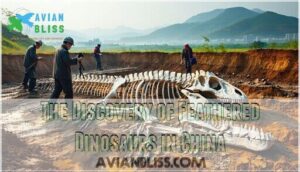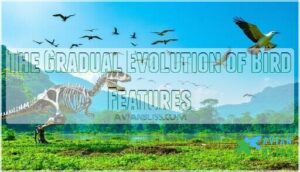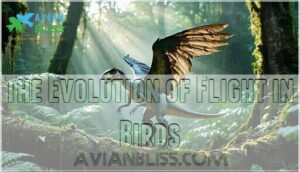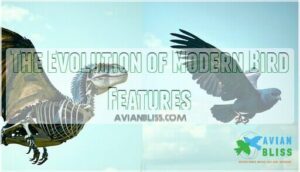This site is supported by our readers. We may earn a commission, at no cost to you, if you purchase through links.

Protein sequences from T. rex fossils echo through modern birds, as if time handed them the family recipe. Shared reproductive traits, nesting habits, and skeletal quirks strengthen the case.
Put simply: birds are the last act in the dinosaur saga, with unexpected twists waiting just ahead.
Table Of Contents
- Key Takeaways
- Birds Evolved From Theropod Dinosaurs
- Feathers and Miniaturization: Key Factors in Bird Evolution
- The Importance of Paedomorphosis in Bird Evolution
- The Evolution of Flight in Birds
- Dinosaurs With Feathers and The Birth of Modern Birds
- Why Are Birds The Only Surviving Dinosaurs?
- Frequently Asked Questions (FAQs)
- Why do paleontologist think birds evolved from dinosaurs?
- Why did researchers think that dinosaurs were ancestors of birds?
- Are birds descended from dinosaurs?
- What evidence supports the theory that birds are descendants of dinosaurs?
- What dinosaur group did modern birds evolve from specifically?
- How long did it take for Archaeopteryx to acquire birdlike features?
- What was the purpose of feathers when they first evolved?
- What happened to the hands of theropod dinosaurs as they evolved into birds?
- What changes occurred in bird skeletons as they evolved for flight?
- How do fossils reveal bird-dinosaur evolutionary steps?
- Conclusion
Key Takeaways
- Birds are directly descended from small, feathered theropod dinosaurs, with fossil and genetic evidence revealing shared features like hollow bones and feathers. – Transitional fossils such as Archaeopteryx and discoveries of feathered dinosaurs in China clearly document the evolutionary steps from dinosaurs to birds. – Key evolutionary shifts included the development of feathers, miniaturization for flight, and the retention of juvenile traits in adult birds. – Birds survived mass extinction events thanks to their adaptability, specialized anatomy, and flight, making them the only living dinosaurs today.
Birds Evolved From Theropod Dinosaurs
Birds didn’t just appear out of thin air—they share deep roots with a fascinating group of ancient dinosaurs.
Here’s what connects them and why that ancient link matters.
Shared Characteristics Between Birds and Dinosaurs
Nearly every time you look at a bird, you’re glimpsing echoes of ancient theropod dinosaurs. Shared characteristics between birds and dinosaurs—such as hollow bones, wishbones, and even feather evolution—make their evolutionary link undeniable. The discovery of collagen protein sequences in T. rex fossils further reinforces this connection.
Consider these immediate connections:
- Anatomical similarities in Skeletal structure
- Bird-like Respiratory systems
- Reproductive traits and nesting behavior
The Discovery of Archaeopteryx and Its Significance
Archaeopteryx makes the story tangible. Discovered in the Solnhofen Quarry just after Darwin’s work shook science, this Transitional Fossil has all the right Avian Ancestry marks—feathers, wishbone, even Skeletal Features you’d expect from dinosaur ancestors.
Its discovery highlights the importance of transitional fossils (https: //www.dinosaur.org/types-of-dinosaurs/archaeopteryx-guide/) in understanding evolutionary processes. Each fossil discovery nudged open the door, offering fossil evidence that the dinosaur-to-bird shift was real, not just speculation.
The Debate Over The Hopeful Monster Theory
Consider this: scientists once argued a Reptile could hatch a bird in a single leap—a “hopeful monster.” But as new fossil discoveries poured in, the Gradualism Debate gained force.
Today’s Modern Consensus? Avian evolution wasn’t driven by sudden Macromutation Viability, but by stepwise evolutionary changes, despite evidence from Hybridization and rare Saltational Evolution events fueling ongoing curiosity.
Phylogenetic Trees and The Bird-Dinosaur Connection
Look beyond big leaps and you’ll spot the real story—unfolding through the branches of evolutionary trees.
Piecing together fossils, genomes, and traits, phylogeny builds a vivid picture that shows how life connects over time.
Fossil placement reveals birds nested deep within the dinosaur ancestry. Clade backing and evolutionary convergence reinforce the bird-dinosaur connection, making modern birds living proof of their dinosaur origins.
Feathers and Miniaturization: Key Factors in Bird Evolution
To understand how birds broke away from their dinosaur roots, it’s worth looking at the big role feathers and body size played.
Here are some key moments that shaped their remarkable transformation.
The Discovery of Feathered Dinosaurs in China
Stunned by how birds got their start? You should be—China’s Liaoning fossils are rewriting everything we thought we knew about dinosaur origins. Suddenly, the fossil evidence comes alive: vibrant feathered diversity, from crow-sized Microraptor to the feather-draped Sinosauropteryx, unfolds in exquisite detail thanks to unparalleled preservation quality in volcanic ash.
These Chinese discoveries aren’t just beautiful—they’re a seismic shift in understanding evolutionary implications. Consider:
- Dozens of distinct feathered dinosaur fossils unearthed. – Ancient feathers captured in fine volcanic sediment. – New links between bird and dinosaur ancestors.
You’re witnessing paleontology’s golden age.
The Gradual Evolution of Bird Features
While examining the evolution of birds, you’ll find that skeletal modifications and feather complexity didn’t erupt overnight. Morphological analyses reveal a feature timeline packed with gradual shifts—wishbones, beaks, and fused bones all emerge incrementally. Transitional evidence, as the table below shows, confirms anatomical rates outpaced those of other theropods, weaving shared ancestral traits into the dinosaur to bird development.
| Feature Timeline | Skeletal Modifications | Anatomical Rates |
|---|---|---|
| Feathers (pre-flight) | Elongated forelimbs | Faster than relatives |
| Wishbone formation | Fused collarbones | Rapid diversification |
| Tail reduction | Hollow bones emerge | Gradual acceleration |
| Beak development | Shortened lower legs | Surpassed theropods |
The Role of Miniaturization in Bird Evolution
If you’ve ever wondered how birds managed to break away from their dinosaur cousins, it all comes down to getting smaller—and fast. This rapid shrinkage, known as miniaturization, let early birds sidestep size constraints imposed on larger dinosaurs.
Selection pressure favored nimbleness and flexibility, opening doors to new habitats and driving paedomorphosis—a shortcut to specialized avian features.
Advantages of Small Size in Early Bird Evolution
Imagine squeezing through thick branches or snatching a hidden meal—being small was the secret superpower that let early birds thrive where their dinosaur relatives just couldn’t fit.
Miniaturization unlocked niche exploitation, greater resource access, and swift predator evasion. Smaller bodies meant lighter bones and efficient flight, enabling birds to meet rising metabolic demands and prompting avian skeletal adaptations important to ongoing bird evolution.
The Importance of Paedomorphosis in Bird Evolution
Paedomorphosis—when adult animals keep their youthful features—has had a surprisingly big influence on how birds became so unique.
Let’s explore how these lasting juvenile traits shaped their evolutionary path.
The Retention of Juvenile Features in Bird Skulls
Here’s a twist in the story of bird evolution—adult bird skulls actually mirror the youthful features of their dinosaur ancestors. This process, known as skull paedomorphosis, means birds retain juvenile traits: a rounded braincase, reduced facial bones, and incompletely ossified structures.
These changes in cranial development and bone ossification set the stage for striking beak evolution and adaptation.
The Connection Between Paedomorphosis and Miniaturization
What happens when evolution hits “rewind” on a dinosaur’s face and dials down its size all at once? Paedomorphosis advantages and miniaturization drivers weren’t just chance events—they steered the trajectory of bird evolution. By locking in juvenile features, birds gained surprising benefits:
- Enhanced skull development for lighter, more aerodynamic heads
- Accelerated brain evolution, making flight navigation possible
- Greater agility and adaptability, unlocking new ecological niches
- Early beak formation tied to changes in facial growth
This dinosaur-to-bird shift, powered by the interplay of paedomorphosis and miniaturization, set the stage for birds’ vast diversity and evolutionary success.
The Evolution of The Beak and Its Functions
As dinosaurs-turned-birds started to shrink and stay youthful, their faces weren’t just getting smaller—their jaws were being reshaped into beaks that opened up a whole new world of feeding tricks.
Beak evolution, driven by skull development and changes in premaxillary bones, led to remarkable beak morphology. These innovations enabled diverse feeding adaptations and even enhanced beak sensory function.
The Role of Paedomorphosis in Bird Brain Development
But the story doesn’t stop with beaks—keeping those youthful features also sparked a leap in brainpower that shaped how birds think and learn today. Thanks to paedomorphosis, their skull morphology remained juvenile, allowing for expanded neural development under evolutionary pressures. The practical benefits? Imagine:
- Greater brain size resulting from juvenile skull proportions, boosting cognitive abilities.
- Curiosity and adaptability—traits often seen in the young—stayed with adult birds, driving problem-solving in harsh habitats.
- Complex social behaviors and tool use flourished, making birds pioneers of innovation among modern animals.
The Evolution of Flight in Birds
Understanding how flight first took off in birds starts with the story of feathers and their original purposes.
Let’s look at the key steps that set the stage for flight.
The Origins of Feathers and Their Functions
Even before birds ruled the skies, feather origins lay with dinosaurs—initially for warmth, display, or signaling rivals, not flight. From fuzzy filaments to elaborate crests, early feather evolution and function intertwined with scales, as revealed by genetic evidence and fossilized skin. Feathered dinosaurs showcase this striking coexistence and stage-wise feather development.
| Stage | Function |
|---|---|
| I | Insulation |
| II | Display |
| III | Camouflage |
| IV | Brooding (eggs) |
| V | Visual signaling |
The Development of Aerodynamic Feathers
Once those early feathers appeared, nature kept tinkering until some became perfectly shaped for slicing through the air. Through feather evolution, feathered dinosaurs saw changes in feather structure—vanes for stability, quills for strength—paving the way for true feather aerodynamics and avian flight.
Fascinated by feather development? Watch for these innovations:
- Interlocking barbs
- Asymmetric vanes
- Hollow shafts
- Lightweight symmetry
- Flexible branching
The Emergence of Wing Movement and Flight
If you’ve ever watched a bird launch skyward in a flurry of feathers, you’ve glimpsed the striking journey that transformed ancient arms into the powerful, coordinated wings that made flight possible.
Through wing stroke evolution and the development of strong flight muscles, early birds refined aerodynamic adaptations—enabling them to generate lift, shift from gliding to powered flight, and explore both soaring and flapping flight strategies.
Dinosaurs With Feathers and The Birth of Modern Birds
Feathered dinosaurs weren’t just prehistoric oddities—they’re the direct link between ancient reptiles and the birds you see today.
Here’s what you’ll want to know about how these notable creatures shaped the story of modern birds.
The Characteristics of Feathered Dinosaurs
What would you make of a creature sporting downy filaments, vibrant plumes, and quilled display feathers? Fossil evidence reveals feathered dinosaurs boasted remarkable feather diversity, reflecting dramatic shifts in both form and function. Let’s break it down:
- Feathered Morphology: From fuzz to complex quills.
- Feather Functions: Insulation, display, and camouflage.
- Temporal Range: Thrived for millions of years.
The Connection Between Feathered Dinosaurs and Modern Birds
Picture the moment you realize every robin or sparrow flitting by is a living echo of creatures that once stalked the ancient forests, their feathers whispering stories that bridge deep time.
Paleontologists connect birds to feathered dinosaurs through three central pillars:
- Fossil evidence reveals shared ancestral traits.
- Anatomical similarities affirm the bird-dinosaur connection.
- Transitional forms highlight ongoing feather evolution and avian ancestry.
The Evolution of Modern Bird Features
Isn’t it wild to think that the traits making sparrows so familiar today—sleek beaks, nimble wings, and hollow bones—are gifts handed down from unlikely ancestors over millions of years?
Beak evolution, skeletal adaptations for flight, feather diversity, sophisticated avian respiration, and soaring metabolic rates all took shape from dinosaur blueprints, forging the unique avian features modern birds display now.
Why Are Birds The Only Surviving Dinosaurs?
Ever wonder why birds are the only dinosaurs still around? Let’s look at what makes them such amazing survivors.
The Unique Characteristics of Birds
What really sets birds apart from the rest of the animal kingdom is a toolkit of tricks left over from their dinosaur ancestors, refined and reimagined for a world that keeps changing. Consider these three hallmarks:
- Avian skeletal structure and metabolic adaptations—lightweight yet powerful for flight.
- Remarkable respiratory system—fueling high activity.
- Feather diversity and sophisticated sensory abilities—allowing birds to thrive in countless ecological niches.
The Role of Adaptation in Bird Evolution
Think of bird evolution as a high-stakes survival race. Their secret? Relentless adaptation, fueled by fast Evolutionary Rates and clever Anatomical Innovation. Miniaturization Effects let theropod ancestors shrink, boosting agility and opening new ecological doors. Feathers, flight adaptation, and a flexible beak created a Survival Advantage, especially in a world shaped by rapid Climate Adaptation.
| Key Adaptation | Survival Benefit |
|---|---|
| Miniaturization | Agile, varied habitats |
| Flight Adaptation | Escape, new food |
| Anatomical Innovation | Niche exploitation |
| Climate Adaptation | Resilience, flexibility |
The Impact of Environmental Factors on Bird Evolution
Just when birds thought they’d mastered the art of adaptation, the world kept throwing fresh curveballs—changing climates, vanishing forests, and shifting food supplies—that pushed their evolution into overdrive.
Evolutionary Pressures sharpened their instincts. Climate Change demanded migration and resilience. Habitat Loss forced creative nesting. Resource Availability sparked startling new beaks and diets. Pollution Effects shaped breeding and survival rates.
Each environmental factor ramped up selective pressure, fueling innovation—allowing evolution’s only winners, modern birds, to thrive in ever-shifting landscapes.
The Reasons for The Survival of Birds
Through every twist in Earth’s story, it’s the striking blend of resilience and adaptability that explains why birds are still with us today. Post-Impact Adaptations, clever Resource Diversification, and the Flight Advantage gave birds options.
Their Metabolic Efficiency and Social Complexity accelerated survival as environmental factors shifted after mass extinction. Miniaturization and swift bird evolution ultimately sealed the fate of modern birds.
Frequently Asked Questions (FAQs)
Why do paleontologist think birds evolved from dinosaurs?
It might seem odd to connect fragile feathers with the hefty bones of dinosaurs, but there’s a clear thread tying them together.
When you look to the Fossil Record, you’ll find striking bone structures, genetic clues, and telltale ancestral features—all pointing toward birds evolving straight out of their theropod dinosaur ancestors.
Why did researchers think that dinosaurs were ancestors of birds?
Spotting a familiar thread in the fossil record, researchers noticed striking skeletal similarities—wishbones, three-toed limbs, even Feather Evolution—that anchor birds to dinosaurs.
This ancestral connection is affirmed through genetic linkage and shift fossils revealing a dinosaur-bird shift.
Are birds descended from dinosaurs?
Like reading a secret message written in stone, you’ll find that birds are living dinosaurs.
Fossils, genetics, and the surprising discovery of dinosaur feathers all come together to show how today’s birds share a deep connection with their theropod dinosaur ancestors along the incredible path of evolution.
What evidence supports the theory that birds are descendants of dinosaurs?
Surprising as it sounds, the fossil record overflows with evidence: Skeletal similarities, feather evolution in theropods, and even genetic analysis all reveal a tight evolutionary link—demonstrating the dinosaur to bird transformation through both fossil and molecular evidence.
What dinosaur group did modern birds evolve from specifically?
Like a family album full of unexpected resemblances, the fossil record reveals that modern birds evolved specifically from small, feathered theropod dinosaurs called coelurosaurs—theropod origins that bridge the dinosaur to bird shift in striking detail.
How long did it take for Archaeopteryx to acquire birdlike features?
Archaeopteryx acquired its defining birdlike traits—such as feathers, wings, and a specialized wishbone—within a narrow window on the evolution timeline, as shown in the fossil record.
This transitional form emerged quickly from feathered theropod dinosaurs.
What was the purpose of feathers when they first evolved?
Back before flight was even possible, feathers mostly acted as a built-in jacket—helping tiny, feathered dinosaurs keep warm.
These structures also played roles in display purposes—attracting mates, frightening rivals—marking a fascinating step in the dinosaur to bird evolution.
What happened to the hands of theropod dinosaurs as they evolved into birds?
Imagine trading grasping claws for wingtips—during theropod evolution, Hand Transformation meant the loss of two fingers, Digit Reduction sculpted aerodynamic wings, and Claw Evolution shifted from hunting tools to the precise, efficient structures behind modern flight.
What changes occurred in bird skeletons as they evolved for flight?
While the invention of smartphones is recent, avian anatomy was innovating millions of years ago. Lighter bones, extensive skeletal fusion, flexible wing joints, and specialized bone structure all fine-tuned the flight mechanics you now see in today’s bird skeletons.
How do fossils reveal bird-dinosaur evolutionary steps?
How do ancient bones whisper their secrets? The fossil record paints each step of the dinosaur to bird transformation—from intermediate forms with feather evolution, to avian skeletal adaptations, to unmistakable skeletal similarities linking bird and theropod dinosaur characteristics.
Conclusion
Imagine future discoveries rewriting the past again—but for now, the evidence tells a powerful story. If you ever wonder why paleontologists believe birds are descended from dinosaurs, just look at the staggering fossil details, genetic echoes, and feathered ancestors that link modern robins with ancient theropods.
The legacy of dinosaurs still soars each morning outside your window, reminding you that every bird call is a whisper from Earth’s most fascinating evolutionary chapter.
- https://timesofindia.indiatimes.com/etimes/trending/99-million-year-old-dinosaur-tail-found-preserved-inside-amber-fossil/photostory/121233755.cms
- https://www.smithsonianmag.com/smart-news/the-famous-feathered-dinosaur-archaeopteryx-could-fly-suggests-new-study-of-a-beautifully-preserved-fossil-180986634/
- https://phys.org/news/2024-05-hidden-dinosaur-feather-evolution.html
- https://www.sciencedirect.com/science/article/pii/S0960982215009458
- https://www.washington.edu/news/2000/08/09/microscopic-bone-evidence-supports-dinosaur-bird-evolution-link/













